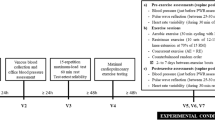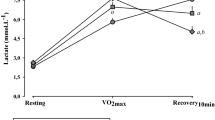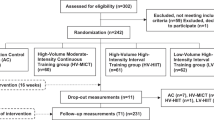Abstract
Aerobic exercise is a powerful mechanism by which cardiovascular and autonomic parameters may be improved. We sought to quantify the extent of benefit that could be achieved by a short-term monitored exercise regimen on several autonomic parameters during recognized mental and physical stressors in young normotensive African-American men matched for a family history of hypertension, a group at high risk for the development of hypertension. Autonomic modulations were derived using spectral decomposition of the electrocardiogram and beat-to-beat blood pressures (BPs). Arterial compliance was obtained using contour analysis of the radial artery pulse wave. The analysis of variance revealed that compared with a matched sedentary control group, aerobic capacity of the trained group significantly increased by 16%. Autonomic modulations, arterial compliance and BP responses significantly improved during some of the stressors, whereas no such improvements were seen in the control group. Attenuated responses, mediated through a favourable shift in sympathovagal balance and enhanced arterial compliance, provide mechanistic evidence of how certain variables may be improved due to aerobic conditioning in a population at high risk for the development of hypertension.
This is a preview of subscription content, access via your institution
Access options
Subscribe to this journal
Receive 12 digital issues and online access to articles
$119.00 per year
only $9.92 per issue
Buy this article
- Purchase on Springer Link
- Instant access to full article PDF
Prices may be subject to local taxes which are calculated during checkout
Similar content being viewed by others
References
Brod J, Fend V, Hejl Z, Jorka G . Circulatory changes underlying blood pressure elevation during acute emotional stress (mental arithmetic) in normotensive and hypertensive participants. Clin Sci 1959; 23: 339–349.
Hollenberg NK, Williams GH, Adams DF . Essential hypertension: abnormal renal vascular and endocrine responses to a mild psychological stimulus. Hypertension 1981; 3: 11–17.
Anderson NB, Lane JD, Marunaka M, Willams RB, Houseworth SJ . Racial differences in blood pressure and forearm vascular responses to the cold face stimulus. Psychosom Med 1988; 50: 57–63.
Dimsdale JE, Graham RM, Ziegler MG, Zusman RM, Berry CC . Age, race diagnosis, sodium effects on the pressor response to infused norepinephrine. Hypertension 1987; 10: 564–569.
Murphy JK, Alpert BS, Moses DM, Somes GW . Race and cardiovascular reactivity: a neglected relationship. Hypertension 1986; 8: 1075–1083.
Sherwood A, Hinderliter AL . Responsiveness to alpha-and beta-adrenergic receptor agonists: effects of race in borderline hypertensive compared to normotensive men. Am J Hypertens 1993; 6: 630–635.
Dimsdale JE, Ziegler M, Mills P, Delehanty SG, Berry C . Effects of salt, race and hypertension on reactivity to stressors. Hypertension 1990; 16: 573–580.
Fagard RH . Prescription and results of physical activity. J Cardiol Pharmacol 1995; 25 (suppl 1): S20–S27.
World Hypertension League. Physical exercise in the management of hypertension. Bull World Health Organ 1991; 69: 149–153.
Veras-Silva AS, Mattos KC, Gava NS, Brum PC, Negrao CE, Krieger EM . Low-intensity exercise training decreases cardiac output and hypertension in spontaneously hypertensive rats. Am J Physiol 1997; 273: H2627–H2631.
Duncan JJ, Far JE, Upton SJ, Hagen RD, Oglesby ME, Blair SN . The effect of aerobic exercise on plasma catecholamine and blood pressure in patients with mild essential hypertension. JAMA 1985; 254: 2609–2613.
Pagani M, Somers V, Furlan R, Dell’Orto S, Conway J, Baselli G et al. Changes in autonomic regulation induced by physical training in mild hypertension. Hypertension 1988; 12: 600–610.
De Meersman R . Heart rate variability and aerobic fitness. Am Heart J 1993; 125: 726–731.
La Rovere MT, Mortara A, Sandrone G, Lombardi F . Autonomic nervous system adaptations to short-term exercise training. Chest 1992; 101: 299S–303S.
Somers VK, Conway J, Johnston J, Sleight P . Effects of endurance training on baroreflex sensitivity and blood pressure in borderline hypertension. Lancet 1991; 337: 1363–1368.
Coats AJ, Adamapoulos S, Radaelli A, McCance A, Meyer TE, Bernardi L et al. Controlled trial of physical training in chronic heart failure. Circulation 1993; 85: 2119–2131.
Pagani M, Somers V, Furlan R, Dell’Orto S, Conway J, Baselli G et al. Changes in autonomic regulation induced by physical training in mild hypertension. Hypertension 1988; 12: 600–610.
Silva GIJ, Brum PC, Negrao CE, Krieger EM . Acute and chronic effects of exercise on baroreflexes in spontaneously hypertensive rats. Hypertension 1997; 30: 714–719.
Vaitkevicius PV, Fleg JL, Engel JH, O’Connor FC, Wright JG, Lakatta LE et al. Effects of age and aerobic capacity on arterial stiffness in healthy adults: inter-relationships between hypertension, left ventricular hypertrophy, and coronary heart disease. Circulation 1993; 88: 1456–1462.
De Meersman R . Aging: a modulator of respiratory sinus arrhythmia. J Gerontol Biol Sc 1993; 48 (2): B74–B78.
Gallagher D, Terenzi T, De Meersman R . Autonomic outflow in smokers, sedentary and aerobically trained individuals. Clin Auton Res 1992; 2 (6): 383–387.
Grim CE, Luft FC, Weinberger MH . Genetic, familial and racial influences on BP control systems in man. Aust NZ J Med 1984; 14: 453–457.
Godin G, Shephard RJ . A simple method to assess exercise behavior in the community. Can J Appl Sport Sci 1985; 10: 141–146.
Bond V, Basset Jr DR, Howley ET, Lewis J, Walker AJ, Swan PD et al. Evaluation of the Colin STBP-680 at rest and during exercise: an automated blood pressure monitor using R-wave gating. Br J Sports Med 1993; 27: 107–109.
Task Force of the European Society of Cardiology and North American Society of Pacing and Electrophysiology. Heart rate variability, standards of measurement, physiological interpretation, and clinical use. Circulation 1996; 93 (5): 1043–1065.
Kannel WB, Wolf PA, McGee DL, Dawber TR, McNamara P, Castelli PW . Systolic blood pressure, arterial rigidity, and risk of stroke. The Framingham study. JAMA 1981; 245: 1225–1229.
De Meersman RE . New noninvasive computerized method for the area measurement of the dicrotic notch. Comp Biol Med 1989; 19 (3): 189–195.
Liu Z, Brinn KP, Yin CPF . Estimation of total arterial compliance: an improved method and evaluation of current methods. Am J Physiol 1986; 251: H588–H600.
De Meersman RE, Reisman S, Daum M, Zorowitz R, Leifer M, Findley T . Influence of respiration on metabolic, hemodynamic, psychometric and R-R interval power spectral parameters. Am J Physiol 1995; 269: H1437–H1440.
Pagani M, Lombardi F, Guzetti S, Rimoldi O, Furlan R, Pizzinelli P et al. Power spectral analysis of heart rate and arterial pressure variabilities and a marker of sympatho-vagal interactions in man and conscious dog. Circ Res 1986; 59: 178–193.
Bertinieri G, Dirienzo M, Cavallazzi A . Evaluation of baroreceptor reflex by blood pressure monitoring in unanesthetized cats. 1981; 254: H377–H383.
De Meersman R, Zion AS, Teitelbaum S, Weir JP, Lieberman JS, Downey JA . Deriving respiration from pulse wave: a new signal-processing technique. Am J Physiol 1996; 270: H1671–H1675.
Eckberg DL . Human sinus arrhythmia as an index of vagal cardiac outflow. J Appl Physiol 1983; 54: 961–966.
Brown TE, Beightol LA, koh J, Eckberg DL . Important influence of respiration on human RR-interval power spectra is largely ignored. J Appl Physiol 1993; 75 (5): 2310–2317.
De Meersman R . Respiratory sinus arrhythmia alteration following training in endurance athletes. Eur J Appl Physiol 1992; 64: 434–436.
Shindo M, Tanaka H, Ohara S, Tokuyama I . Training 55% O2max on healthy middle-aged men by bicycle ergometer. Rep Res Cent Phys Educ 1974; 2: 139–152.
Tipton CM, Matthes RD, Marcus KD, Rowlett KA, Leininger RJ . Influences of exercise intensity, age, and medication on resting systolic blood pressure of SHR populations. 1983; 55: 1305–1310.
Winder WW, Beattie MA, Holman RT . Endurance training attenuates stress hormone responses to exercise in fasted rats. Am J Physiol 1982; 243: R179–R184.
Somers VK, Conway J, Johnston J, Sleight P . effects of endurance training on baroreflex sensitivity and blood pressure in borderline hypertension. Lancet 1991; 337: 1363–1368.
Anderson N, Lane J, Monou H . Racial differences in cardiovascular reactivity to mental arithmetic. Int J Psychophysiol 1988; 6: 161–164.
Clark R . Perceptions of interethnic group racism predict increased vascular reactivity to a laboratory challenge in college women. Ann Behav Med 2000; 22 (3): 214–222.
Grassi G . role of the sympathetic nervous system in human hypertension. J Hypertens 1998; 16: 1979–1987.
Esler MD, Lambert G, Jennings G . Regional norepinephrine turnover in human hypertension. Clin Exp Hypertens 1989; 1 (Suppl): 75–89.
Valbo AB, Hagbarth KE . Activity from skin mechanoreceptors recorded percutaneously in awake human participants. Exp Neurol 1968; 21: 270–289.
Ferrier C, Esler MD, Eisenhofer G . Increased norepinephrine spillover into cerebrovascular circulation in essential hypertension: evidence of high central nervous system norepinephrine turnover. Hypertension 1992; 19: 62–69.
Licht KC, Obrist PA, Sherwood A, James S, Strogatz D . Effects of race and marginally elevated blood pressure on cardiovascular responses to stress in young men. Hypertension 1987; 10: 555–569.
La Rovere MT, Mortara A, Sandrone G, Lombardi F . Autonomic nervous system adaptations to short-term exercise training. Chest 1992; 101: 299S–303S.
Somers VK, Conway J, Johnston J, Sleight P . Effects of endurance training on baroreflex sensitivity and blood pressure in borderline hypertension. Lancet 1991; 337: 1363–1368.
Bengel DH . The dynamic elastic properties of the arterial wall. J Physiol 1961; 156: 458–469.
Cox RH . Effects of norepinephrine on mechanics of arteries in vivo. Am J Physiol 1976; 231: 420–425.
Gerova M, Gero J . Range of sympathetic control of the dog femoral artery. Circ Res 1969; 24: 349–359.
Cox RH, Bagshaw RJ . Effects of pulsations on carotid sinus control of regional hemodynamics. Am J Physiol 1980; 238: H182–H190.
Boutouyrie P, Lacolley P, Girard X, Beck L, Safar M, Laurent S . Sympathetic activation decreases medium sized arterial compliance in humans. Am J Physiol 1994; 267: H1368–H1377.
Masuo K, Mikami H, Ogihara T, Tuck ML . Sympathetic nerve hyperactivity precedes hyperinsulinemia and blood pressure elevation in a young, nonobese Japanese population. Am J Hypertens 1997; 10: 77–83.
Julius S, Esler MD, Randall OR . Role of autonomic nervous system in mild hypertension. Am Heart J 1975; 48: 243s–252s.
Julius S . Sympathetic hyperactivity and coronary risk in hypertension. Hypertension 1993; 21: 886–893.
Acknowledgements
Supported by National Institutes of Health, Grant no. S08016-30 (VB) and VIDDA Foundation (RED) and RO1 HL61287 (RPS).
Author information
Authors and Affiliations
Corresponding author
Additional information
DisclosureNone.
Rights and permissions
About this article
Cite this article
Bond, V., Bartels, M., Sloan, R. et al. Exercise training favourably affects autonomic and blood pressure responses during mental and physical stressors in African-American men. J Hum Hypertens 23, 267–273 (2009). https://doi.org/10.1038/jhh.2008.125
Received:
Revised:
Accepted:
Published:
Issue Date:
DOI: https://doi.org/10.1038/jhh.2008.125
Keywords
This article is cited by
-
A scoping review of risk behaviour interventions in young men
BMC Public Health (2014)



